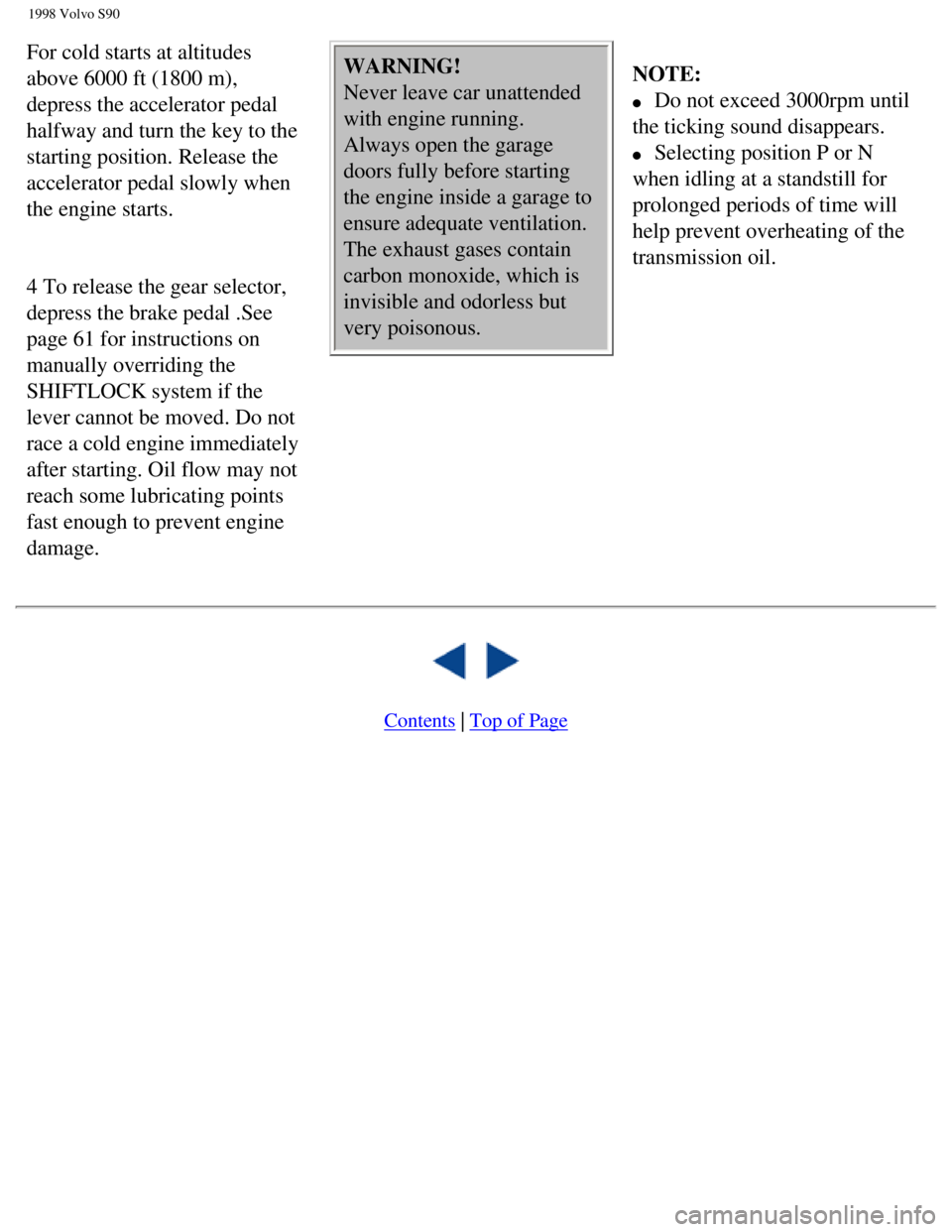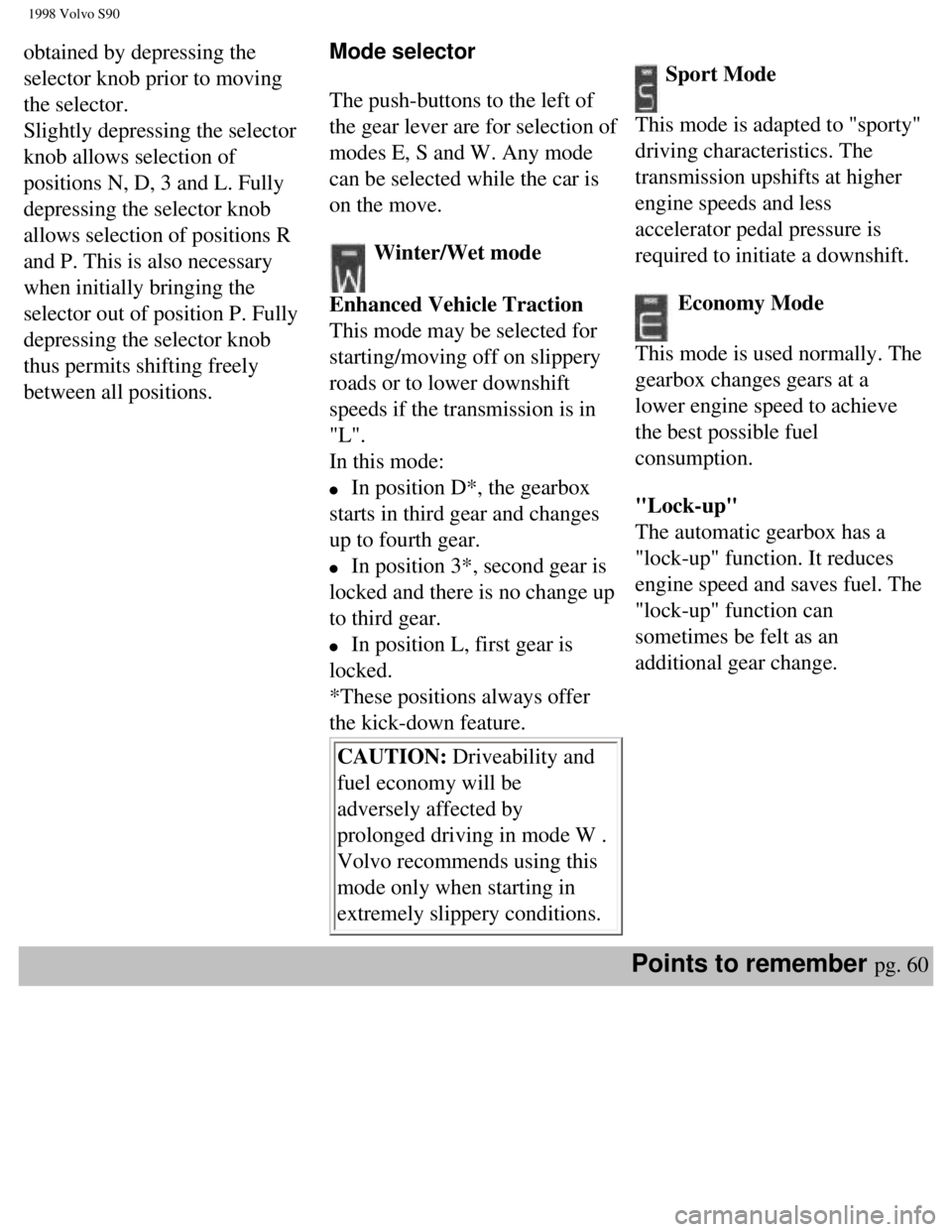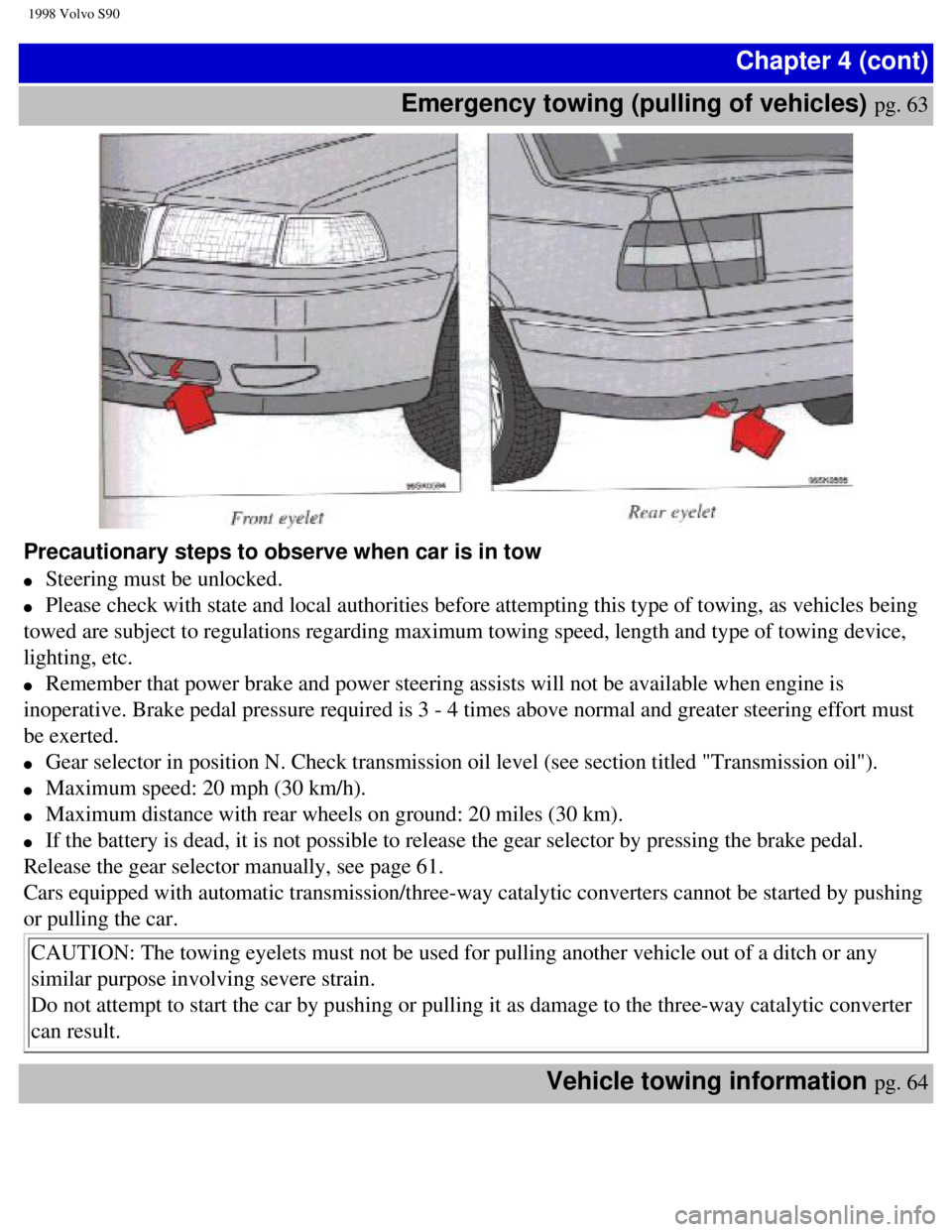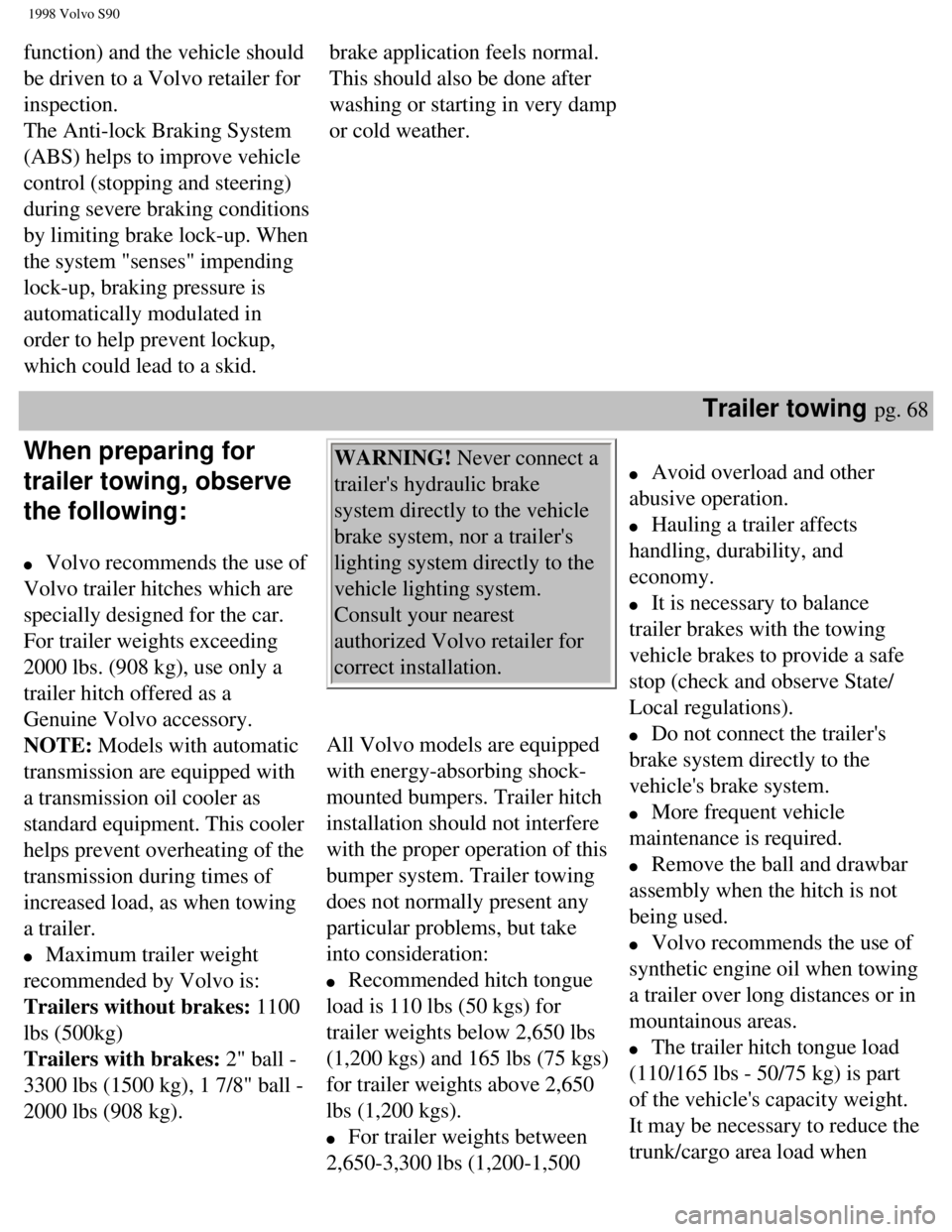1998 VOLVO V90 transmission
[x] Cancel search: transmissionPage 65 of 175

1998 Volvo S90
For cold starts at altitudes
above 6000 ft (1800 m),
depress the accelerator pedal
halfway and turn the key to the
starting position. Release the
accelerator pedal slowly when
the engine starts.
4 To release the gear selector,
depress the brake pedal .See
page 61 for instructions on
manually overriding the
SHIFTLOCK system if the
lever cannot be moved. Do not
race a cold engine immediately
after starting. Oil flow may not
reach some lubricating points
fast enough to prevent engine
damage. WARNING!
Never leave car unattended
with engine running.
Always open the garage
doors fully before starting
the engine inside a garage to
ensure adequate ventilation.
The exhaust gases contain
carbon monoxide, which is
invisible and odorless but
very poisonous.
NOTE:
l Do not exceed 3000rpm until
the ticking sound disappears.
l Selecting position P or N
when idling at a standstill for
prolonged periods of time will
help prevent overheating of the
transmission oil.
Contents | Top of Page
file:///K|/ownersdocs/1998/1998_SV90/98S90_053.htm (6 of 6)12/30/2006 \
1:52:41 PM
Page 66 of 175

1998 Volvo S90
Chapter 4 (cont)
Automatic transmission
pg. 58
P(Park)
Use this position when
starting the engine or parking
the car.
Never use P while car is in
motion.
The transmission is
mechanically locked when in
position P. Also use the
parking brake when parking
on grades.
The gear selector is locked in
the P position (Shift lock). To
release the selector, start the
engine and depress the brake
pedal. See page 61 for
instructions on manually
releasing the gear selector. WARNING!
Never leave the car when
the engine is running. If, by
mistake, the gear selector is
moved from P the car may
start moving.
R(Reverse)
Never engage R while car is
moving forward.
N(Neutral)
Neutral position = no gear is
engaged.
Use parking brake. The
engine can be started with
the gear selector in this
position.
D(Drive)
D is the normal driving
position and should be used
as often as possible to help
improve fuel economy.
When modes E or S are
selected, upshift and
downshift of the forward
gears occur automatically
and are governed by
accelerator pedal position
and vehicle speed.
3 (Intermediate position)
Automatically shifts up and
down between first second
L (Low gear)
The gearbox does not upshift in
position L! Select position L if you
wish to drive in first or second gear
and you do not wish to shift up (when
driving in hilly terrain, for example, as
position L provides the best engine
braking power). The transmission will
conspicuously shift down from second
to first if road speed drops to below 25
or 20 mph (40 km/h or 30 km/h)
(engines B6304 and B6254
respectively) when driving in
Economy mode. When driving in
Sport mode, the same very noticeable
shift takes place if the speed drops to
below 6 mph (10 km/h).
file:///K|/ownersdocs/1998/1998_SV90/98S90_058.htm (1 of 7)12/30/2006 \
1:52:42 PM
Page 67 of 175

1998 Volvo S90
and third gears when in
driving modes E or S. There
is no upshift from third gear.
Position 3 can be used for
driving in hilly terrain, for
towing trailers or for
increased engine braking
power.
CAUTION: Never select P
or R while the car is in
motion. When initially
selecting positions D, 3, L
or R, your right foot should
press firmly on the brake
pedal to ensure that the car
is standing still with the
engine idling. The gear
selector should not be
downshifted to L at speeds
above 75 mph (125 km/h). -
Always observe posted
speed limits!
Automatic transmission pg. 59
Shift gate positions
The gear selector can be moved
freely between D and 3.
Selections of other positions are
Kick-down
Automatic shift to a lower gear
(kick-down) is achieved by
depressing the accelerator pedal
fully and briskly.
An up-shift will be achieved
when approaching the top speed
for a particular gear or by
releasing the accelerator pedal
slightly. Kick-down can be used
for maximum acceleration or
when passing at highway
speeds.
The indicator lamp in the
instrument panel lights up when
mode W is selected. Press button
W in order to disengage this
mode.
When mode W is disengaged,
the gearbox automatically
reverts to the previously selected
S or E mode.
If the indicator lamp begins to
flash, this is an indication of a
fault in the automatic gearbox. If
the transmission does not shift
properly, place the gear selector
in position L. Please contact
your Volvo retailer if this
occurs.
file:///K|/ownersdocs/1998/1998_SV90/98S90_058.htm (2 of 7)12/30/2006 \
1:52:42 PM
Page 68 of 175

1998 Volvo S90
obtained by depressing the
selector knob prior to moving
the selector.
Slightly depressing the selector
knob allows selection of
positions N, D, 3 and L. Fully
depressing the selector knob
allows selection of positions R
and P. This is also necessary
when initially bringing the
selector out of position P. Fully
depressing the selector knob
thus permits shifting freely
between all positions.Mode selector
The push-buttons to the left of
the gear lever are for selection of
modes E, S and W. Any mode
can be selected while the car is
on the move.
Winter/Wet mode
Enhanced Vehicle Traction
This mode may be selected for
starting/moving off on slippery
roads or to lower downshift
speeds if the transmission is in
"L".
In this mode:
l In position D*, the gearbox
starts in third gear and changes
up to fourth gear.
l In position 3*, second gear is
locked and there is no change up
to third gear.
l In position L, first gear is
locked.
*These positions always offer
the kick-down feature.
CAUTION: Driveability and
fuel economy will be
adversely affected by
prolonged driving in mode W .
Volvo recommends using this
mode only when starting in
extremely slippery conditions.
Sport Mode
This mode is adapted to "sporty"
driving characteristics. The
transmission upshifts at higher
engine speeds and less
accelerator pedal pressure is
required to initiate a downshift.
Economy Mode
This mode is used normally. The
gearbox changes gears at a
lower engine speed to achieve
the best possible fuel
consumption.
"Lock-up"
The automatic gearbox has a
"lock-up" function. It reduces
engine speed and saves fuel. The
"lock-up" function can
sometimes be felt as an
additional gear change.
Points to remember pg. 60
file:///K|/ownersdocs/1998/1998_SV90/98S90_058.htm (3 of 7)12/30/2006 \
1:52:42 PM
Page 69 of 175

1998 Volvo S90
Special Tips - automatic transmission
l For driving down steep hills and when driving
for prolonged periods at low speeds, position L
should be selected. Avoid, however, repeated
changes since this can cause overheating of the
transmission oil. For driving on long continuous
uphill gradients, select position 3.
l Do not hold the car stationary on an incline by
using the accelerator pedal. Instead, apply the
hand brake (parking brake). This prevents the
transmission oil from becoming overheated.
l When towing a trailer, select shift position 3.
l The (E)conomy mode should be selected when
the cruise control is engaged.
l Never select P or R while the car is in motion.
l When initially selecting positions D, 3, L or R,
your right foot should press firmly on the brake
pedal to ensure that the car is standing still with
the engine idling.
l The gear selector should not be downshifted to
L at speeds above 75 mph (125 km/h). Always
observe posted speed limits. Cooling system
The risk for overheating is greatest, especially in
hot weather, when:
l towing a trailer up steep inclines for prolonged
periods at wide open throttle and low engine rpm.
l stopping the engine suddenly after high speed
driving (so-called "after-boiling" can occur).
To avoid overheating, the following rules should
be followed:
l Reduce speed and downshift when towing a
trailer up long, steep inclines. The risk of
overheating can be reduced by switching off the
air conditioning system for a short time.
l Do not let the engine idle unnecessarily for
prolonged periods.
l Do not mount auxiliary lamps in front of the
grill.
When the risk of overheating is imminent, or in
the event of overheating, (the temperature gauge
goes repeatedly into, or stays continually in, the
red section) the following precautions should be
taken:
l Switch off the air conditioning system.
l Pull off the road, away from traffic, stop the car
and put the gear lever into neutral. Do not stop the
engine!
l Switch the heater to full (maximum) position.
Increase the engine speed to approx. 2000 rpm
(twice idling speed) until the temperature begins
to drop.
See "Coolant" to check and top-up the coolant
level if necessary.
WARNING! Do not remove coolant expansion
tank cap. The coolant will be extremely hot.
Points to remember pg. 61
file:///K|/ownersdocs/1998/1998_SV90/98S90_058.htm (4 of 7)12/30/2006 \
1:52:42 PM
Page 73 of 175

1998 Volvo S90
Chapter 4 (cont)
Emergency towing (pulling of vehicles)
pg. 63
Precautionary steps to observe when car is in tow
l Steering must be unlocked.
l Please check with state and local authorities before attempting this typ\
e of towing, as vehicles being
towed are subject to regulations regarding maximum towing speed, length \
and type of towing device,
lighting, etc.
l Remember that power brake and power steering assists will not be availab\
le when engine is
inoperative. Brake pedal pressure required is 3 - 4 times above normal a\
nd greater steering effort must
be exerted.
l Gear selector in position N. Check transmission oil level (see section \
titled "Transmission oil").
l Maximum speed: 20 mph (30 km/h).
l Maximum distance with rear wheels on ground: 20 miles (30 km).
l If the battery is dead, it is not possible to release the gear selector \
by pressing the brake pedal.
Release the gear selector manually, see page 61.
Cars equipped with automatic transmission/three-way catalytic converters\
cannot be started by pushing
or pulling the car.
CAUTION: The towing eyelets must not be used for pulling another vehicle\
out of a ditch or any
similar purpose involving severe strain.
Do not attempt to start the car by pushing or pulling it as damage to th\
e three-way catalytic converter
can result.
Vehicle towing information pg. 64
file:///K|/ownersdocs/1998/1998_SV90/98S90_063.htm (1 of 4)12/30/2006 \
1:52:43 PM
Page 78 of 175

1998 Volvo S90
function) and the vehicle should
be driven to a Volvo retailer for
inspection.
The Anti-lock Braking System
(ABS) helps to improve vehicle
control (stopping and steering)
during severe braking conditions
by limiting brake lock-up. When
the system "senses" impending
lock-up, braking pressure is
automatically modulated in
order to help prevent lockup,
which could lead to a skid. brake application feels normal.
This should also be done after
washing or starting in very damp
or cold weather.
Trailer towing pg. 68
When preparing for
trailer towing, observe
the following:
l Volvo recommends the use of
Volvo trailer hitches which are
specially designed for the car.
For trailer weights exceeding
2000 lbs. (908 kg), use only a
trailer hitch offered as a
Genuine Volvo accessory.
NOTE: Models with automatic
transmission are equipped with
a transmission oil cooler as
standard equipment. This cooler
helps prevent overheating of the
transmission during times of
increased load, as when towing
a trailer.
l Maximum trailer weight
recommended by Volvo is:
Trailers without brakes: 1100
lbs (500kg)
Trailers with brakes: 2" ball -
3300 lbs (1500 kg), 1 7/8" ball -
2000 lbs (908 kg).
WARNING! Never connect a
trailer's hydraulic brake
system directly to the vehicle
brake system, nor a trailer's
lighting system directly to the
vehicle lighting system.
Consult your nearest
authorized Volvo retailer for
correct installation.
All Volvo models are equipped
with energy-absorbing shock-
mounted bumpers. Trailer hitch
installation should not interfere
with the proper operation of this
bumper system. Trailer towing
does not normally present any
particular problems, but take
into consideration:
l Recommended hitch tongue
load is 110 lbs (50 kgs) for
trailer weights below 2,650 lbs
(1,200 kgs) and 165 lbs (75 kgs)
for trailer weights above 2,650
lbs (1,200 kgs).
l For trailer weights between
2,650-3,300 lbs (1,200-1,500
l Avoid overload and other
abusive operation.
l Hauling a trailer affects
handling, durability, and
economy.
l It is necessary to balance
trailer brakes with the towing
vehicle brakes to provide a safe
stop (check and observe State/
Local regulations).
l Do not connect the trailer's
brake system directly to the
vehicle's brake system.
l More frequent vehicle
maintenance is required.
l Remove the ball and drawbar
assembly when the hitch is not
being used.
l Volvo recommends the use of
synthetic engine oil when towing
a trailer over long distances or in
mountainous areas.
l The trailer hitch tongue load
(110/165 lbs - 50/75 kg) is part
of the vehicle's capacity weight.
It may be necessary to reduce the
trunk/cargo area load when
file:///K|/ownersdocs/1998/1998_SV90/98S90_067.htm (2 of 5)12/30/2006 \
1:52:43 PM
Page 79 of 175

1998 Volvo S90
Observe legal requirements of
the state in which the vehicles
are registered.
WARNING! Bumper-
attached trailer hitches must
not be used on Volvos, nor
should safety chains be
attached to the bumper.
Trailer hitches attaching to
the vehicle rear axle must
not be used. kgs) a top speed of 50 mph (80
km/h) should never be
exceeded.
l Increase tire pressure to
recommended full-load
pressure. See section "Wheels
and tires".
l Engine and transmission are
subject to increased loads.
Therefore, engine coolant
temperature should be closely
watched when driving in hot
climates or hilly terrain. Use
lower gear and turn off air
conditioner if temperature gauge
pointer enters the red range.
towing a trailer to ensure that the
max. permissible axle load or
gross vehicle weight are not
exceeded.
NOTE: Refer to section
"Automatic transmission" for
additional trailer hauling tips.
Winter driving pg. 69
Cold weather precautions
l If you wish to check your car before the
approach of cold weather, the following advice is
worth noting:
Make sure that the engine coolant contains at least
50 percent antifreeze: that is, 5.3 qts. (5 liters)
Volvo Genuine Coolant/Antifreeze. This gives
protection against freezing down to -31°F (-35°
C). See section "Coolant".
The use of "recycled" antifreeze is not approved
by Volvo. Different types of antifreeze may not be
mixed.
l Try to keep the fuel tank well filled - this
prevents the formation of condensation in the
tank.
In addition in extremely cold weather conditions it
is worthwhile to add fuel line de-icer before
refueling.
l The viscosity of the engine oil is important. Oil
with low viscosity (thinner oil) improves cold-
weather starting as well as decreasing fuel
consumption while the engine is warming up. For
winter use, 5W-30 oil, particularly the synthetic
type, is recommended.
Be sure to use good quality oil but do not use this
l The Volvo Washer Solvent should be diluted as
follows:
Down to 14°F (-10°C): 1 part anti-freeze and 4
parts water
Down to 5°F (-15°C): 1 part anti-freeze and 3
parts water
Down to 0°F (-18°C): 1 part anti-freeze and 2
parts water
Down to -18°F (-28°): 1 part anti-freeze and 1
part water
l Use lock spray or grease in the locks.
NOTE: Avoid the use of de-icing spray as they
can cause damage to the locks.
Automatic differential lock (certain
models)
The differential automatically locks at speed
between 3 - 25 mph (5 - 40 km/h) if either of the
drive wheels begins to lose traction. The
differential lock improves power distribution to
the drive wheels in slippery conditions, shifting
power to the wheel with best traction. It also
file:///K|/ownersdocs/1998/1998_SV90/98S90_067.htm (3 of 5)12/30/2006 \
1:52:43 PM